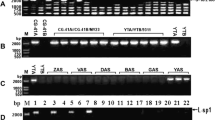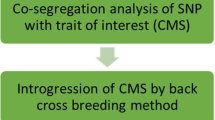Abstract
A real-time fluorescent PCR (RTF-PCR) was developed to detect and quantify wild abortive (WA)-type three-line hybrid rice (Oryza sativa L.). The mitochondrial R2-630 WA gene was reported to be closely related to male sterility in plants, and developed as a molecular maker to identify the cytoplasmic male sterility system of hybrid rice. First, we got the DNA sequence of R2-630 WA gene in 17 rice species with traditional PCR. Then, a pair of specific primers (P3, P4) and TaqMan fluorescence probe (P3-14) were designed based on the R2-630 DNA sequence. The following RTF-PCR was performed on the 17 rice species finally. The results indicate that the probes used here are specific for three-line hybrid rice F1 and male sterile lines. We can even identify a single hybrid seed using the probes, which confirmed that the probes can be applied to the identification and quantification of the WA-type three-line hybrid rice. In addition, the RFT-PCR system can be optimized when the annealing temperature is 60 °C and the Mg2+ concentration is 3.5 mmol/L.





Similar content being viewed by others
References
Akagi, H. (1994). A unique sequence located downstream from the rice mitochondrial atp6 RNA S may cause male sterility. Current Genetics, 25, 52–58.
Cao, A. X., Liu, X. Z., Zhu, S. F., & Lu, B. S. (2005). Detection of the pinewood nematode, Bursaphelenchus xylophilus, using a real-time polymerase chain reaction assay. Phytopathology, 95, 566–571.
Cao, C. (2008). Chinese hybrid rice: the answer to the global food shortage. China Economic Weekly, 18, 22–24.
Chen, Y.J., Yuan G.B., and Deng, Y. (2011). Research on the opportunities, problems and countermeasures of China hybrid rice seed “going out”. Issues in Agricultural Economy.6:21–25.
Cheng, S. H., Zhuang, J. Y., Fan, Y. Y., Du, J. H., & Cao, L. Y. (2007). Progress in research and development on hybrid rice: a super-domesticate in China. Annals of Botany, 100, 959–966.
Huang, Z. C., Huang, W. Z., Yan, M. J., et al. (2009). Identification of true or false and purity of hybrid rice with SSR molecular marker. Journal of Anhui Agricultural Sciences, 37(8), 3437–3438. In Chinese.
Kadowaki, K. A. (1990). Chimerit gene containing the 5′ portion of atp6 is associated with cytoplasmic male sterility of rice. Molecular and General Genetics, 224, 106–116.
Leonardo, S., Nigro, F., Ipplito, A., & Gallitelli, D. (2004). Real-time quantitative PCR: a new technology to detect and study phytopathogenic and antagonistic fungi. European Journal of Plant Pathology, 110, 893–908.
Levings, C. S., & Pring, D. R. (1976). Restriction endonuclease analysis of mitochondrial DNA from normal and Texas cytoplasmic male-sterile maize. Science, 193, 158–169.
Licciardello, G., Grasso, F. M., Bella, P., Cirvilleri, G., Grimaldi, V., & Catara, V. (2006). Identification and detection of Phoma tracheiphila, causal agent of citrus mal secco disease, by real-time polymerase chain reaction. Plant Disease, 89, 1523–1530.
Li, Z. H., Zhu, K. Y., Chen, Z. W., & Zhan, Q. C. (2006). Application of SSR molecular marker on purity identification of hybrid rice seeds. Hybrid Rice, 21, 11–14. In Chinese.
McDonald, M. B., Elliot, L. J., & Sweeney, P. M. (1994). DNA extraction from dry seeds for RAPD analyses in varietal identification studies. Seeds Science and Technology, 22, 171–176.
Namrata, S., Singh, M., Kumar, S., Kumar, R., Singh, V., Prasanna, H. C., et al. (2007). RAPD markers for hybrid seed purity testing in tomato (Solanum lycopersicum L.). Current Science, 93, 462–463.
Nandakumar, N., Singh, A. K., & Sharma, R. K. (2004). Molecular fingerprinting of hybrids and assessment of genetic purity of hybrid seeds in rice using microsatellite markers. Euphytica, 136, 257–264.
Semagn, K., Bjornstad, A., & Ndjiondjop, M. N. (2006). An overview of molecular marker methods for plants. African Journal of Biotechnology, 5, 2540–2568.
Sundaram, R. M., Naveenkumar, B., Biradar, S. K., Balachandran, S. M., Mishra, B., Iiyaahmed, M., et al. (2008). Identification of informative SSR markers capable of distinguishing hybrid rice parental lines and their utilization in seed purity assessment. Euphytica, 163, 215–224.
Temnykh, S., Park, W. D., Ayres, N., Cartinhour, S., Hauck, N., Lipovich, L., et al. (2000). Mapping and genome organization of microsatellite sequences in rice (Oryza sativa L.). Theoretical and Applied Genetics, 100, 697–712.
Wang, A. S., Li, J. B., & Liu, H. Z. (2005). Research advance on application of DNA fingerprinting to identification seed purity and authenticity in hybrid rice. Plant Molecular Breeding, 3, 393–400. In Chinese.
Xu, W., Virmani, S. S., Hernandez, J. E., Sebastian, L. S., Redona, E. D., & Li, Z. (2002). Genetic diversity in the parental lines and heterosis of the tropical rice hybrids. Euphytica, 127, 139–148.
Xu, R. L., Xie, D., Shi, S. Y., Lu, W. Z., Guo, W., & Wang, M. X. (1995). Cloning and sequence analysis of specific mitchondrial DNA fragment related to wild abortive type cytoplasmic male sterity in rice. Acta Botanic Sinica, 37, 501–506. In Chinese.
Yang, J. B., Wang, X. F., Zhao, C. S., Xiang, T. H., & Li, N. (2002). Cloning and sequencing of fragments associated with cytoplasm male sterility of rice. Acta Genetica Sinica, 29, 808–813. In Chinese.
Yang, L. T., Chen, J. X., Huang, C., Liu, Y. H., Jia, S. R., Pan, L. W., et al. (2005). Validation of a cotton-specific gene, Sad1, used as an endogenous reference gene in qualitative and real-time quantitative PCR detection of transgenic cottons. Plant Cell Reports, 24, 237–245.
Yuan, L. P. (2002). Hybrid rice. Beijing: Chinese Agricultural Press (In Chinese). Bei Jing.
Acknowledgments
This work was partly funded by molecular marker system of bio-resources General Administration of Quality Supervision, Inspection and Quarantine of the People’s Republic of China. The authors would like to thank Dr. H.L. Yang from the China National Hybrid Rice Research and Development Center, Dr. W.X. Zhang from the Institute of Crop Germplasm Resource Chinese Academy of Agricultural Sciences (CAAS) and Dr. S.W. Huang from the China National Rice Research Institute for the donation of samples. We are grateful to Professor J. Leng and W. Li from the Institute of Bast-Fiber and L. Yu from Hunan Agricultural University for their critical reading and editing of the manuscript.
Author information
Authors and Affiliations
Corresponding authors
Rights and permissions
About this article
Cite this article
Cheng, Y., Gao, B.D., Chen, H.Y. et al. Identification of WA-Type Three-Line Hybrid Rice with Real-Time Polymerase Chain Reaction (PCR) Method. Appl Biochem Biotechnol 166, 819–829 (2012). https://doi.org/10.1007/s12010-011-9471-0
Received:
Accepted:
Published:
Issue Date:
DOI: https://doi.org/10.1007/s12010-011-9471-0




